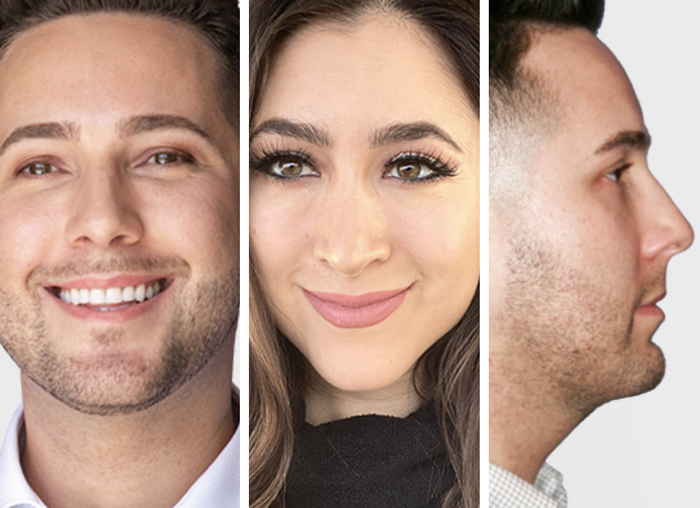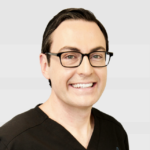Soft tissue fillers are used to add volume to the face, to treat deep folds and creases. The first approved and most commonly area treated is the nasolabial folds (the lines beside the mouth, sometimes called “parentheses”). Fillers are placed beneath the skin surface to fill in and hide these folds, resulting in an improved contour and a more youthful face. Other areas frequently treated include the lines and folds below the corners of the mouth (often called “marionette lines” because of the resemblance to the mouth of a puppet), the lower eyelid region (often called the “tear troughs” because of the hollow area below the eyes, near the tear ducts), the lips, the cheeks, and the temple region (side of the face, above and in front of the ears). Finally, soft tissue fillers can be used to camouflage depressed scars in some cases.
Explore our
Patient Gallery
*Actual patients in photos

Dr. Ransom is skilled in the use of Voluma®, Restylane®, Juvederm®, Juvederm Volbella®, Restylane Defyne®, Restylane Refyne®, Restylane Silk®, Belotero®, and Radiesse®. He uses each of these products according to patient preference. Dr. Ransom uses blunt-tipped microcannulas for sensitive tissues of the face, such as the under-eye or tear trough area. In addition, Dr. Ransom recommends the use of specific fillers in certain areas of the face due to the different thickness and durability of each filler formulation. In addition, each patient has a unique underlying bone structure and tissue characteristics. By employing a combination of fillers in an overall treatment program, sometimes called a “liquid lift” or “filler facelift”, Dr. Ransom can give you a quick, non-surgical rejuvenation without any downtime! Many patients will combine soft tissue filler treatments with Botox® Cosmetic or Dysport® for a simple, refreshing update to their look, or add a chemical peel or laser treatment for a complete non-surgical makeover! Please visit the photo gallery for examples. Also, more information about fillers is available on our pages for non-surgical chin and cheek augmentation, as well as non-surgical rhinoplasty.
Who is a candidate?
Anyone who is looking to add volume to the face or treat deep lines and folds is a candidate for soft tissue fillers. Depending on the areas you want to be treated, and the severity of the folds or devolumization, different filler products may be recommended. The only contraindications for filler injections are active infection in the area to be injected or a history of allergic reaction to the product. Dr. Ransom can discuss the details of filler treatments, and the “liquid lift”, during your consultation. In addition, certain fillers (e.g., Radiesse® or Voluma®) can be used for non-surgical facial augmentation in the chin area, the cheekbones, or the nose.
Frequently Asked Questions
Please note that all patients are different and individual healing times and results may vary. The statements regarding procedures and recovery made here are general rules.
Most of the commonly used soft tissue fillers today are made of synthetic hyaluronic acid (HA), a natural component of cartilage. This material is safe, non-toxic, and does not spread throughout the body. Examples include Voluma®, Restylane®, Juvederm®, Belotero®, and Perlane®. In addition to the volume of the material injected, HA is very hydrophilic – meaning it attracts water molecules. This increases its potential for revolumization. Lastly, HA is easily broken down by an enzyme called hyaluronidase (marketed as Vitrase or Wydase), which can be used to reverse the treatment or reduce areas that are overfilled, if needed.
Radiesse® is a different material, know as calcium hydroxyapatite. This is a natural component of bone, but is used in a gel form for soft tissue filling. Calcium hydroxyapatite is also safe and non-toxic, and does not spread throughout the body after injected. The advantage of Radiesse is that it lasts longer than HA-based fillers. It is thicker, however, and is therefore not suitable in all parts of the face. Finally, studies have shown that calcium hydroxyapatite filler injections may stimulate your body to make more collagen, leading to a permanent improvement in soft tissue volume.
Different fillers last for different amounts of time, and there is certainly some variability between patients. This variability depends on each persons’ unique metabolism, level of activity, diet, and other factors. In general, the HA fillers will last six to nine months, though some patients will receive a longer effect. Calcium hydroxyapatite (i.e., Radiesse®) lasts longer, generally a year or more in some people. A new kind of longer-acting HA filler has just been released: Voluma®. This product has been shown to last up to 2 years in clinical trials. It is an excellent option for midface and cheek augmentation that is safe, long-lasting, and even reversible if needed.
This depends on which filler is used and where it is placed. HA fillers (see above) can be dissolved using a tiny dose of an enzyme. If needed, this is a quick procedure and the enzyme reduces the filler volume within a couple days. Calcium hydroxyapatite fillers cannot be dissolved once injected, though they are metabolized by the body over time.
This is a common question for first-time patients. Dr. Ransom uses a specially formulated topical numbing cream before filler treatments to make the process as comfortable as possible. In addition, he uses fillers that have been pre-mixed with numbing medicine, so that each injection is accompanied by a small dose. Finally, for sensitive areas such as the lips, Dr. Ransom can perform specific nerve blocks to make the procedure completely painless. All patients are then encouraged to ice the treated areas in our office afterward. Our goal is to make you as comfortable as possible during your visit!
Absolutely! In fact, Dr. Ransom recommends specific fillers for specific areas of the face and specific aesthetic goals. It is very common to use Restylane® for the under-eye area, followed by Juvederm® for the folds around the mouth, and Radiesse® for the temples, jawline, and upper cheeks. A new filler that is now available is Voluma®, which can be used for longer-lasting volumization of the entire cheek and midface areas. This can be combined with any of the above treatments in a single, refreshing session.
Dr. Evan Ransom is an Ivy League-educated and Ivy League trained Facial Plastic and Reconstructive Surgeon. He is a Double Board Certified Head and Neck Surgeon and Facial Plastic and Reconstructive Surgery and fellowship-trained in facial plastic, reconstructive, and laser surgery. His practice is in the San Francisco Bay Area, serving patients from San Francisco, Oakland, Marin County, Palo Alto, Silicon Valley, Walnut Creek, the East Bay, and all over Northern California.
 (415) 550-1077
(415) 550-1077 San Francisco
San Francisco




